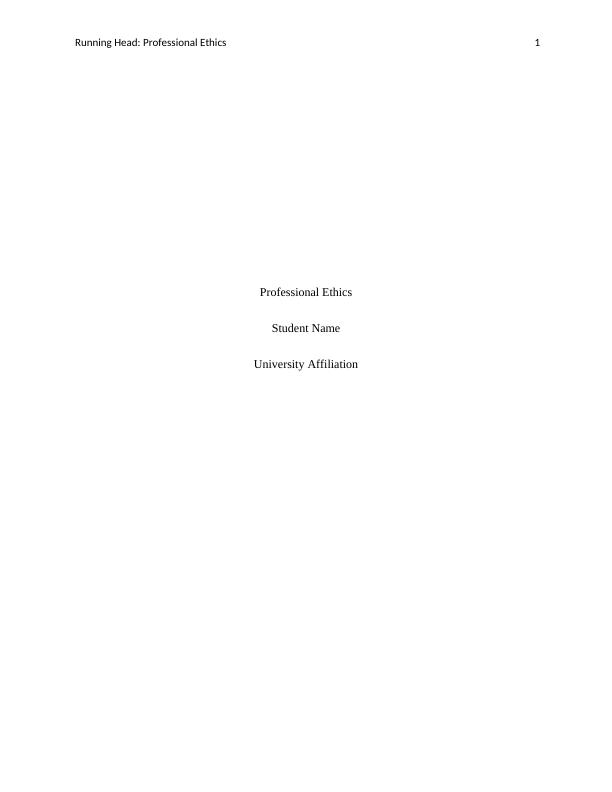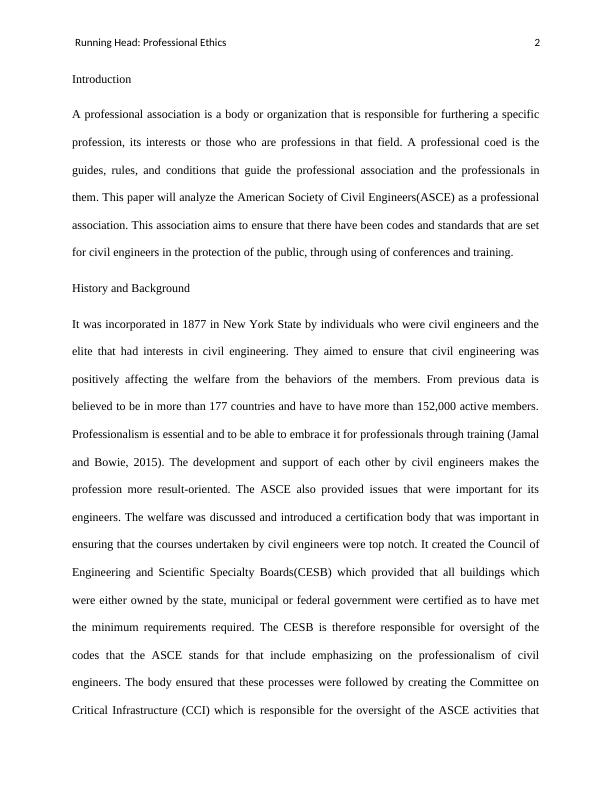Professional Ethics in American Society of Civil Engineers
Added on 2023-06-04
6 Pages1583 Words59 Views
Running Head: Professional Ethics 1
Professional Ethics
Student Name
University Affiliation
Professional Ethics
Student Name
University Affiliation

Running Head: Professional Ethics 2
Introduction
A professional association is a body or organization that is responsible for furthering a specific
profession, its interests or those who are professions in that field. A professional coed is the
guides, rules, and conditions that guide the professional association and the professionals in
them. This paper will analyze the American Society of Civil Engineers(ASCE) as a professional
association. This association aims to ensure that there have been codes and standards that are set
for civil engineers in the protection of the public, through using of conferences and training.
History and Background
It was incorporated in 1877 in New York State by individuals who were civil engineers and the
elite that had interests in civil engineering. They aimed to ensure that civil engineering was
positively affecting the welfare from the behaviors of the members. From previous data is
believed to be in more than 177 countries and have to have more than 152,000 active members.
Professionalism is essential and to be able to embrace it for professionals through training (Jamal
and Bowie, 2015). The development and support of each other by civil engineers makes the
profession more result-oriented. The ASCE also provided issues that were important for its
engineers. The welfare was discussed and introduced a certification body that was important in
ensuring that the courses undertaken by civil engineers were top notch. It created the Council of
Engineering and Scientific Specialty Boards(CESB) which provided that all buildings which
were either owned by the state, municipal or federal government were certified as to have met
the minimum requirements required. The CESB is therefore responsible for oversight of the
codes that the ASCE stands for that include emphasizing on the professionalism of civil
engineers. The body ensured that these processes were followed by creating the Committee on
Critical Infrastructure (CCI) which is responsible for the oversight of the ASCE activities that
Introduction
A professional association is a body or organization that is responsible for furthering a specific
profession, its interests or those who are professions in that field. A professional coed is the
guides, rules, and conditions that guide the professional association and the professionals in
them. This paper will analyze the American Society of Civil Engineers(ASCE) as a professional
association. This association aims to ensure that there have been codes and standards that are set
for civil engineers in the protection of the public, through using of conferences and training.
History and Background
It was incorporated in 1877 in New York State by individuals who were civil engineers and the
elite that had interests in civil engineering. They aimed to ensure that civil engineering was
positively affecting the welfare from the behaviors of the members. From previous data is
believed to be in more than 177 countries and have to have more than 152,000 active members.
Professionalism is essential and to be able to embrace it for professionals through training (Jamal
and Bowie, 2015). The development and support of each other by civil engineers makes the
profession more result-oriented. The ASCE also provided issues that were important for its
engineers. The welfare was discussed and introduced a certification body that was important in
ensuring that the courses undertaken by civil engineers were top notch. It created the Council of
Engineering and Scientific Specialty Boards(CESB) which provided that all buildings which
were either owned by the state, municipal or federal government were certified as to have met
the minimum requirements required. The CESB is therefore responsible for oversight of the
codes that the ASCE stands for that include emphasizing on the professionalism of civil
engineers. The body ensured that these processes were followed by creating the Committee on
Critical Infrastructure (CCI) which is responsible for the oversight of the ASCE activities that

Running Head: Professional Ethics 3
include the planning, construction, observation and measurement, response and recovery,
infrastructure resilience and event mitigation. The ASCE is working together with nations to
ensure that the Federal and State government assist in coming up with legislation that enables for
the improvement of the nation's infrastructure and the enhancement of the engineering specialty
(Newberry, 2014). It is done through lobbying on such legislation by the ASCE.
Advocacy of ASCE
This advocacy has led to a few developments and achievements. They include the adoptions of
federal programs that are highly dependent on civil engineering. These programs include the
areas of research and development, environment, education, aviation, water resources. It assisted
in ensuring that there was no division of roles when a project was to be undertaken. The
advocacy also led to the funding of the Science Technology, Engineering and Mathematics
(STEM) programs. It assisted in ensuring that those that chose these academic disciplines that
are competitive had enough funding. Funding is done through the provision of adequate
equipment for learning, sufficient and qualified teachers and the enabling of better curriculum
practices. They ensured that there was an incentive act passed to address the building code. This
act was to provide that there would be the provision of disaster relief to states that were abiding
and implementing the strong building codes that had been set by the ASCE. There was a need to
address natural hazards. Natural hazards include earthquakes, floods, and storms (Vee and
Skitmore, 2013). This lobbying was significant for the enactment to ensure that in specific
geographical locations specifically designed buildings that were disaster-resistant were built.
Personal reflection
include the planning, construction, observation and measurement, response and recovery,
infrastructure resilience and event mitigation. The ASCE is working together with nations to
ensure that the Federal and State government assist in coming up with legislation that enables for
the improvement of the nation's infrastructure and the enhancement of the engineering specialty
(Newberry, 2014). It is done through lobbying on such legislation by the ASCE.
Advocacy of ASCE
This advocacy has led to a few developments and achievements. They include the adoptions of
federal programs that are highly dependent on civil engineering. These programs include the
areas of research and development, environment, education, aviation, water resources. It assisted
in ensuring that there was no division of roles when a project was to be undertaken. The
advocacy also led to the funding of the Science Technology, Engineering and Mathematics
(STEM) programs. It assisted in ensuring that those that chose these academic disciplines that
are competitive had enough funding. Funding is done through the provision of adequate
equipment for learning, sufficient and qualified teachers and the enabling of better curriculum
practices. They ensured that there was an incentive act passed to address the building code. This
act was to provide that there would be the provision of disaster relief to states that were abiding
and implementing the strong building codes that had been set by the ASCE. There was a need to
address natural hazards. Natural hazards include earthquakes, floods, and storms (Vee and
Skitmore, 2013). This lobbying was significant for the enactment to ensure that in specific
geographical locations specifically designed buildings that were disaster-resistant were built.
Personal reflection

End of preview
Want to access all the pages? Upload your documents or become a member.
